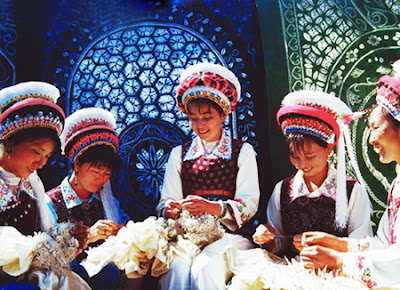Yunnan, also named as Dian for short, is situated in the Southwest frontier of China. Stretching about 865 kilometers from east to west and 990 kilometers from north to south, it covers an area of 394,000 square kilometers. Accounting for 4.1 percent of the total land area of China, it is the 8th largest province in China; with Kunming being its capital city; Yunnan has 8 municipalities and 8 minority autonomous prefectures under jurisdiction altogether. Yunnan is also situated in the southwestern part of the Yunnan-Guizhou Plateau. It borders on Guizhou Province and Guangxi Zhuang Autonomous Region in the southeast, Sichuan Province in the northeast and Tibet Autonomous Region in the northwest. In its west and south Yunnan shares a common border with Myanmar, Laos and Vietnam along a total boundary of 4,060 kilometers. In the bordering area, there are 12 national border ports, 8 provincial border ports, and over 90 routes leading into the neighboring countries. In addition, Yunnan is geographically proximate to Thailand, Cambodia, Bangladesh and India. Since ancient times, Yunnan has been serving as China's gateway to Southeast Asia and South Asia and is a convergence for oriental and western cultures. The Southern Silk Road which existed 2,000 years ago started its journey from Sichuan to Yunnan, and extended from Yunnan further down to Southeast Asia, Central Asia, the Arabia region, and the West.
Yunnan's climate turns out to be the subtropical plateau monsoon type. Thanks to its unique geographic location, highly complex topography, and big variations in elevation, Yunnan exhibits diversified climates. The major characteristics include: slight temperature variation year round but sharp between day and night; distinct dry and rainy seasons and an obvious altitudinal variation in climate. Generally speaking, the temperature drops by 0.5 ℃ with every altitudinal 100-meter rise. The diversity of Yunnan's climatic types could be better described with a local saying, "One can experience all four seasons in the same mountain and each season is just a few miles away from each other".
Rainfall in this province is abundant but distributes unevenly; and in most areas, the annual rainfall is more than 1,000 mm with about 85 percent concentrating in the months from May to October; dry season falls between November and April during which the precipitation accounts for only 15 percent. Throughout the province, the frost-free period is long; the southern border area of the province is free from frost all year round while the frost-free period a bit further north ranges from 300 to 330 days; in the central part, the frost-free period is about 250 days and even in the comparatively colder northwestern and northeastern parts, 210 to 220 days are immune from frost.
Kunming:
Kunming is the capital of Yunnan Province. It is not only the political, economic, cultural, technological and communication center of the province but also a historical and cultural city with rich tourism resources. Here Spring is hovering over all year round, flowers are everywhere and greens in every season with an average temperature of 15.3℃, hence the other name Spring City.
Dali:
Located northwest of the Yunnan, Dali City is the economic and cultural center of the Bai Autonomous Prefecture. The name of Dali is originated from that of a local regime in history called Kingdom Dali, meaning a state of great order. Many of the architectures of the city were built of marble from the ore nearby, and that is why it is also called a city of Dali Stone (marble). Both Chinese writing and pronunciation of 'great order' and 'marble' are the same. Marble buildings, marble streets, marble wall foundations and marble wells make the city so bright and limpid as if it is a tranquil fairyland. Each family loves door carving and wall-decoration; every household has a flower garden. While it is freezing season in the north, hundreds of flowers are in blossom here. Among them, camellia, azaleas and orchids are the most fascinating and enchanting ones.
Lijiang:
Lijiang City is located in the northwestern portion of Yunnan and borders Sichuan. It is in a region where the Qinghai-Tibet Plateau and Yunnan-Guizhou Plateau converge.
Lijiang includes the heritage site of Lijiang Ancient Town as well as picturesque nearby surroundings. In 1998, Lijiang Ancient Town was inscribed into the World Heritage List by the World Heritage Commission of the UNESCO. The Commission called it an exceptional ancient town set in a dramatic landscape which represents the harmonious fusion of different cultural traditions to produce an urban landscape of outstanding quality.
POSTED BY XU JI









No comments:
Post a Comment